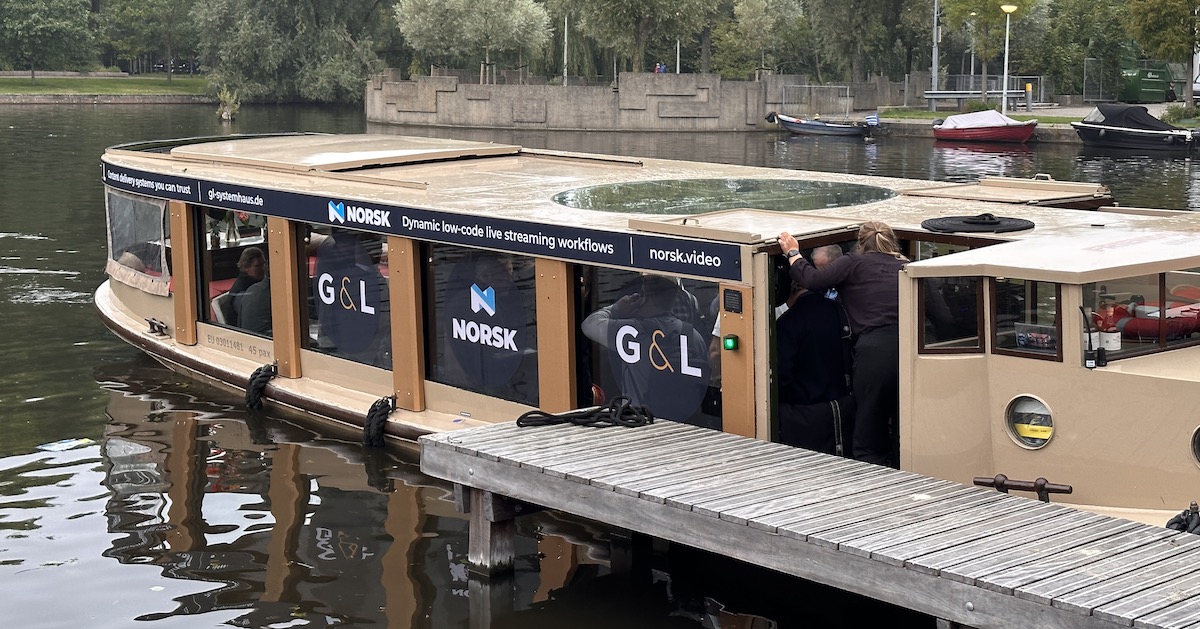IBC 2023 may not have been exactly a triumphant return to pre-pandemic form, but it was close. According to the organizers, more than 43,000 people attended the biggest gathering of broadcasters and streamers in Europe, a 16% increase over 2022 but still a far cry from the 56,000+ attendees in 2019. The number of exhibitors was up, too: 1,250 compared to 1,000 in 2022—but again, far fewer than the 1,700 we saw in 2019.
But bigger isn’t always better. To be honest, the numbers this year feel about right for a venue the size of the RAI and a city the size of Amsterdam. There’s a tendency in the conference industry, just as in the media industry, to chase big numbers—attendance, ratings, gross revenues—at the cost of audience experience, quality, and profitability. (Not to say “I told you so,” but I’ve been harping on this theme since 2009.)
Norsk wasn’t among the exhibitors, and that was by design. Instead, we focused on quality rather than quantity. Our meeting calendar was full; in fact, we had only a single one-hour break from the time the show opened on Friday morning until it closed Monday afternoon. Unless you’re chasing commodity leads or trying to make a big splash—or, let’s face it, you’ve had a booth at IBC for years, so why stop now, and in fact, we’d better be as big or bigger than last year or people will talk—the ROI on big trade shows is debatable.
There were more after-hours events this year, too, including the canal cruise that Norsk sponsored with our wonderful partners G&L Geißendörfer & Leschinsky to take people from “The Beach” at the RAI to the DASH-IF networking event at the Heineken Experience. But again, the DASH-IF party wasn’t sardine-tin packed like it was in past years; you could actually move around and enjoy the music from DJs like our own Dom Robinson (aka Voice of Doom) and AWS Elemental’s Nicolas Weil (aka DJ Reelup).

And let’s face it: If the media industry doesn’t make some major changes, IBC is going to get smaller, not bigger. Media cartographer Evan Shapiro outlined this in his opening keynote, we’re not on the cusp of a disruption, we’re in the midst of an apocalypse, and it’s clear that media companies need to not just iterate and evolve but reinvent themselves and rethink how they do everything. I sadly missed the keynote, but he previewed those themes in an interview and during an enlightening discussion over dinner on the eve of the conference.
He expanded on the keynote in a typically provocative post on his Media War & Peace blog this week.
That doesn’t mean we drop everything and wait for the C-suite to figure it all out. Whether it’s “new media” that takes the lead or “old media” that finally adapts—or some of both—we firmly believe they’ll be using technologies like Norsk to help make it happen.
Within the big picture, a few key themes emerged from IBC. Each is something we can act on, and they’re all interconnected. Here are our takeaways:
1. It’s Time to Focus on Cost Savings
After a decade of emphasis on growth, broadcasters and streaming services now need to be laser-focused on profitability. That means they’re looking for tech solutions that can help them maximize the efficiency of their systems and teams, and that means solutions that can help them cut costs wherever possible. This focus on cost savings is a thread that runs through all of the following takeaways.
2. Concerns About the Cloud
For the last five years, it’s been all about the cloud. More and more businesses, however, are looking at the downsides of the cloud—CAPEX cost, loss of control—and big publishers are realizing they’re sometimes using only a small percentage of their commits and asking themselves if it’s worth it. They’re also looking at the upsides of hardware, particularly hardware acceleration on cards like those from NETINT and AMD, and seeing the benefits of bringing at least some of their processes back on-prem. That brings increased OPEX costs, but the capacity of some of these cards is mind-boggling, and for all but the biggest publishers, on-prem makes a lot of sense. Cloud is going to continue to grow—and cloud providers are likely to embrace hardware acceleration as well—but publishers are going to be more strategic about how they deploy it. Ultimately, it comes down to each publisher’s individual needs, and there’s no one-size-fits-all answer.
3. “He that gets hurt will be he who has stalled”
Grammatical inconsistencies aside, Bob Dylan’s line from “The Times They Are A-Changin’” has never been more relevant. From media publisher C-suites to developer sandboxes, we’re beginning to see the negative impacts of “we’ve always done it that way.” Shapiro likes to talk about our industry as being full of dinosaurs, and our co-founder Adrian Roe takes it a step further—they’re staring up at the light in the sky and saying “Oooh, shiny!” with no awareness that it’s about to make them extinct. Again and again over the weekend, we saw the tension between next-generation technologies and entrenched attitudes, internal politics, and an unhealthy attachment to legacy systems. Media technology is complicated, and now that just about every company is a media company, it’s our job to make it simpler for our customers–not revel in our mastery of that complexity for the sake of short-term revenue or job security. Anything else is simply rearranging deck chairs on the Titanic.

4. Getting Smart About AI
Sure, just about every stand at IBC included some mention of AI, but there’s a healthy skepticism (or maybe it’s just realism) about its limitations. Norsk is a perfect example: With the ChatGPT plugin, a customer could ask Norsk to build reasonably complex workflows, but ChatGPT isn’t anywhere near capable of doing the same thing with the code that’s underneath our abstraction layer (what were we just saying about complexity?).
5. Getting Real About Sustainability
As the founders of Greening of Streaming, id3as might be biased, but the broadcast and streaming industry is finally getting serious about sustainability—and getting serious means knowing when to say “I don’t know,” rather than doubling down on carbon savings or energy reduction claims that can’t be backed up. There were more discussions and presentations about sustainability in the conference program than there were in 2022, and fewer splashy badges on stands. Less hype is a good thing, suggesting that sustainability has finally become ingrained in organizational cultures, rather than being seen as a marketing box to be ticked off and touted. And Greening of Streaming’s LESS Accord is gaining traction as one possible avenue to affect real, measurable, and substantial change—one of many to come, we hope.